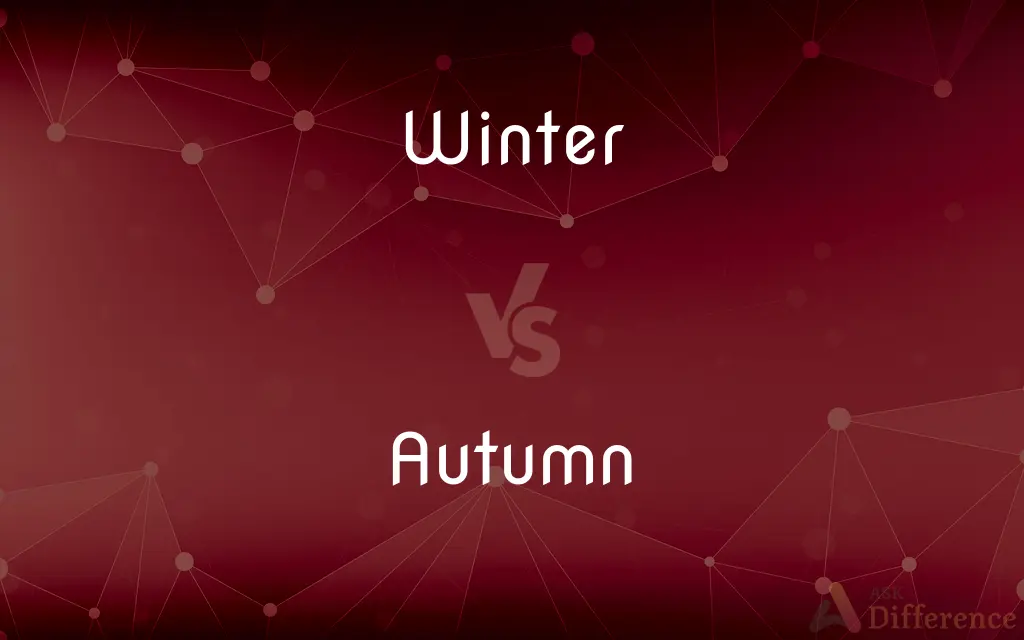Winter vs. Autumn — What's the Difference?
Edited by Tayyaba Rehman — By Fiza Rafique — Published on March 4, 2024
Winter is characterized by the coldest season with snow and shorter days, while Autumn is known for its mild temperatures, falling leaves, and preparation for winter.

Difference Between Winter and Autumn
Table of Contents
ADVERTISEMENT
Key Differences
Winter and Autumn are distinct seasons marked by their unique weather patterns and natural phenomena. Winter is the coldest season, often bringing snow, ice, and freezing temperatures, which dramatically influence daily life and natural landscapes. In contrast, Autumn is a transitional season, where temperatures gradually decrease from the warmth of summer to the chill of winter, characterized by the shedding of leaves from deciduous trees.
During Winter, days are significantly shorter, and nights are longer due to the tilt of the Earth's axis away from the sun in the respective hemisphere. This results in less sunlight and lower temperatures. Autumn, however, is known for its balanced days and nights, especially during the equinox, leading to a pleasant climate before the harshness of winter.
Winter activities often include skiing, snowboarding, and ice skating, taking advantage of the snow and ice. Autumn activities, on the other hand, involve apple picking, pumpkin carving, and enjoying the colorful foliage, which celebrates the beauty of change and prepares people for the coming cold.
In terms of cultural significance, Winter is associated with major holidays such as Christmas and New Year, fostering family gatherings and festive celebrations. Autumn is closely linked with harvest festivals, Thanksgiving in the United States, and the aesthetic appreciation of nature's transformation.
The environmental impact of each season is also noteworthy. Winter's cold can be challenging for wildlife, leading to migration, hibernation, or adaptation strategies. Autumn is a critical time for many species, as they prepare for winter by storing food or growing thicker fur, showcasing nature's cycle of preparation and survival.
ADVERTISEMENT
Comparison Chart
Temperatures
Generally below freezing in many areas
Mild, cooling down from summer
Daylight
Shortest days, especially near the solstice
Decreasing daylight, balanced at the equinox
Activities
Skiing, snowboarding, ice skating
Apple picking, pumpkin carving, leaf peeping
Cultural Significance
Christmas, New Year
Harvest festivals, Thanksgiving
Environmental Impact
Challenges for wildlife, migration/hibernation
Preparation for winter, storing food, adaptation
Compare with Definitions
Winter
The coldest season of the year, often associated with snow.
During winter, the town is covered in a thick blanket of snow.
Autumn
The season between summer and winter, characterized by falling leaves.
Autumn is when the forest turns into a canvas of orange and red.
Winter
A period of dormancy or inactivity.
The garden enters its winter after the first frost.
Autumn
A period of maturity or the late stages of life.
He's in the autumn of his career, looking to retire soon.
Winter
A metaphor for a period of hardship or desolation.
The loss marked the beginning of a long winter in her life.
Autumn
Used to describe a period of decline or nearing end.
The project was in its autumn, with completion on the horizon.
Winter
The quarter of the year in some cultures associated with the north.
Winter brings the longest nights of the year.
Autumn
A metaphor for change or transformation.
The nation was in the autumn of its imperial glory.
Winter
A term used to describe the later years of life.
In the winter of his life, he took to writing his memoirs.
Autumn
The quarter of the year associated with the west in some cultures.
Autumn equinox marks the balance of day and night.
Winter
In the Northern Hemisphere, usually the coldest season of the year, occurring between autumn and spring and including the months of December, January, and February. In the Southern Hemisphere austral winter includes June, July, and August.
Autumn
The season of the year between summer and winter, during which the weather becomes cooler and many plants become dormant, extending in the Northern Hemisphere from the autumnal equinox to the winter solstice and popularly considered to include the months of September, October, and November; fall. In the Southern Hemisphere autumn includes March, April, and May.
Winter
A period of time characterized by coldness, misery, barrenness, or death.
Autumn
Relating to or occurring in autumn
Autumn foliage.
Autumn harvests.
Winter
Traditionally the fourth of the four seasons, typically regarded as being from December 23 to March 20 in continental regions of the Northern Hemisphere or the months of June, July, and August in the Southern Hemisphere. It is the time when the sun is lowest in the sky, resulting in short days, and the time of year with the lowest atmospheric temperatures for the region.
Autumn
To undergo the changes associated with autumn, such as leaves changing color and falling from trees.
Winter
The season of the year in which the sun shines most obliquely upon any region; the coldest season of the year.
And after summer evermore succeedsBarren winter, with his wrathful nipping cold.
Winter lingering chills the lap of May.
Autumn
The third season of the year, or the season between summer and winter, often called "the fall." Astronomically, it begins in the northern temperate zone at the autumnal equinox, about September 23, and ends at the winter solstice, about December 23; but in popular language, autumn, in America, comprises September, October, and November.
Winter
The coldest season of the year; in the northern hemisphere it extends from the winter solstice to the vernal equinox
Autumn
The season when the leaves fall from the trees;
In the fall of 1973
Common Curiosities
How do daylight hours change in winter compared to autumn?
Daylight hours are shortest in winter, especially near the solstice, while autumn experiences a gradual decrease in daylight.
What defines the start of winter?
Winter begins at the winter solstice, the day with the shortest period of daylight.
What is the main characteristic of autumn?
Autumn is characterized by the cooling temperatures and the changing colors of leaves.
What are typical winter activities?
Typical winter activities include skiing, snowboarding, and ice skating.
How do animals adapt to the coming of winter during autumn?
Animals prepare for winter by storing food, migrating, or growing thicker fur.
What holidays are commonly associated with winter?
Winter is associated with holidays like Christmas and New Year.
What is the significance of the autumn equinox?
The autumn equinox marks the day when day and night are of equal length, signaling the start of autumn.
Can winter temperatures vary by geographical location?
Yes, winter temperatures can significantly vary depending on geographical location.
What cultural festivals are celebrated in autumn?
Harvest festivals and Thanksgiving are prominent cultural celebrations in autumn.
What signifies autumn in the natural world?
The shedding of leaves from deciduous trees and the harvest period signify autumn.
Is autumn considered a time of beauty in nature?
Yes, autumn is often celebrated for its beautiful changing foliage and scenic landscapes.
Do all countries experience winter at the same time?
No, the Northern and Southern Hemispheres experience winter at opposite times of the year.
Why is autumn also called fall?
Autumn is called fall in North America, referring to the falling leaves of deciduous trees.
What environmental challenges does winter present?
Winter poses challenges such as harsh temperatures, snowfall, and ice, affecting both humans and wildlife.
How does wildlife behavior change in winter?
Wildlife may migrate, hibernate, or adapt to survive the cold and scarcity of food.
Share Your Discovery

Previous Comparison
Parellelogram vs. Quadrilateral
Next Comparison
Primary Storage vs. Secondary StorageAuthor Spotlight
Written by
Fiza RafiqueFiza Rafique is a skilled content writer at AskDifference.com, where she meticulously refines and enhances written pieces. Drawing from her vast editorial expertise, Fiza ensures clarity, accuracy, and precision in every article. Passionate about language, she continually seeks to elevate the quality of content for readers worldwide.
Edited by
Tayyaba RehmanTayyaba Rehman is a distinguished writer, currently serving as a primary contributor to askdifference.com. As a researcher in semantics and etymology, Tayyaba's passion for the complexity of languages and their distinctions has found a perfect home on the platform. Tayyaba delves into the intricacies of language, distinguishing between commonly confused words and phrases, thereby providing clarity for readers worldwide.













































